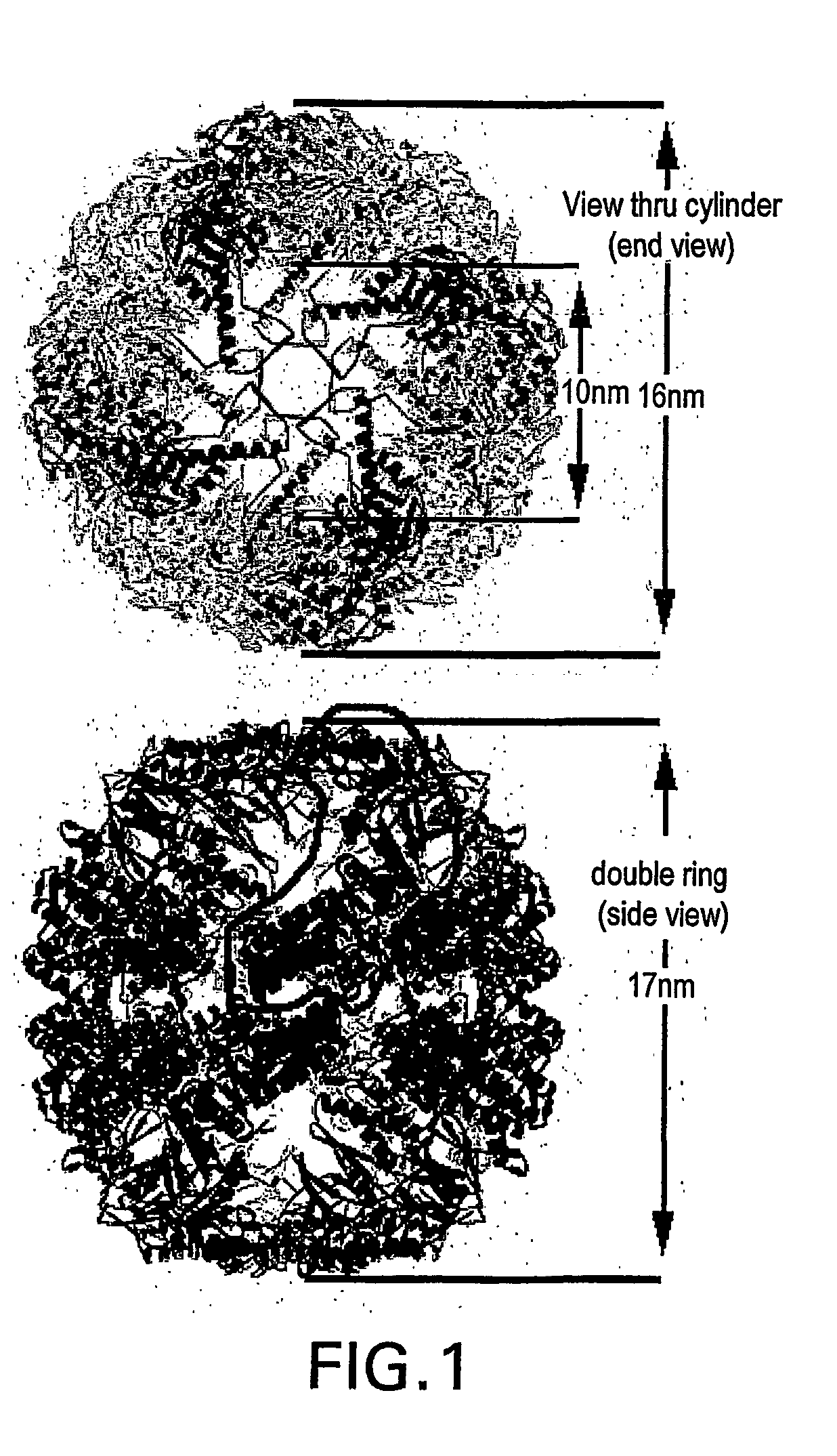Ordered biological nanostructures formed from chaperonin polypeptides
a polypeptide and biological nanotechnology, applied in the field of nanostructures, nanostructures, nanoarrays and nanodevices, can solve the problems of prohibitively expensive and time-consuming ion and electron beam lithography, techniques possess inherent limitations, and the practical and theoretical limits of conventional lithographic processes
- Summary
- Abstract
- Description
- Claims
- Application Information
AI Technical Summary
Benefits of technology
Problems solved by technology
Method used
Image
Examples
example 6.1
Models
[0157] A homology model for S. shibatae HSP60beta was made using the web-based service Swiss Model (http: / / www.expasy.ch / swissmod / SWISS-MODEL.html). Seven PDB entries of solved structures of homologous proteins were used as templates scoring between 48% and 64% sequence identity in pairwise alignment with native S. shibatae beta. The structure was relaxed in vacuo with the GROMOS96 force field. Symmetric operations werer applied to the subunit to form nine-fold symmetrical rings which were assembled into 18-mer chaperoning. All models were constrained by dimensions observed for different chaperonin views as measured in the TEM.
example 6.2
Cloning and Sequencing of the Gamma Gene of S. Shibatae
[0158] The gamma gene was amplified by the polymerase chain reaction (PCR) method from S. shibatae genomic DNA purified using Qiagen Genomic Tips (Qiagen). PCR primers (P1: 5′-ATGAACTTAGAGCCTTCCTAT-3 (SEQ ID NO:33) and P2: 5′-TTAACTCCATAAGAAACTTGT-3′) (SEQ ID NO:34) were based on previously published partial gamma sequence information (Archibald et al., 1999, Current Biology 9, 1053-1056). The inverse-PCR method (Ochman et al., 1988, Genetics 120, 621-623) was used to obtain the complete gamma gene and its flanking regions. Briefly, AseIdigested genomic DNA was circularized by self-ligation and a 1.2 kbp fragment was obtained by PCR amplification after 25 cycles (30 sec at 94° C., 1 min at 50° C., and 1 min at 72° C.), using Vent polymerase (New England Biol.abs). The PCR fragment was ligated into pBluescript SK(+) (Stratagene) to obtain a plasmid which was transformed into E. coli (strain DH5α). The gamma gene was sequenced o...
example 6.3
Expression of the Gamma Gene of S. Shibatae in E. Coli
[0159] The complete gamma gene PCR was amplified from S. shibatae genomic DNA using a pair of primers (Primer 1: 5′ GAAAGAACATATGGCCTATTTATTAAGAGAAGGAACACAG-3′ (SEQ ID NO:35) and Primer 2: 5′-TAAAGTACTCGAGAAAACCTAAATAAAATAATCATATCTTAAC-3′ (SEQ ID NO:36)). This fragment was cloned into the Nde I and Xho I sites of the plasmid vector pET22b (Novagen). Expression in E. coli strain BL21(DE3) “codon plus” in LB media containing 50 mg / ml carbenicillin (Sigma) was under isopropyl β-D thiogalactopyranoside (IPTG) regulation. The alpha and beta genes were similarly expressed (Kagawa et al., 1995, J. Mol. Biol. 253,712-725).
PUM
| Property | Measurement | Unit |
|---|---|---|
| size | aaaaa | aaaaa |
| size | aaaaa | aaaaa |
| concentration | aaaaa | aaaaa |
Abstract
Description
Claims
Application Information
 Login to View More
Login to View More - R&D
- Intellectual Property
- Life Sciences
- Materials
- Tech Scout
- Unparalleled Data Quality
- Higher Quality Content
- 60% Fewer Hallucinations
Browse by: Latest US Patents, China's latest patents, Technical Efficacy Thesaurus, Application Domain, Technology Topic, Popular Technical Reports.
© 2025 PatSnap. All rights reserved.Legal|Privacy policy|Modern Slavery Act Transparency Statement|Sitemap|About US| Contact US: help@patsnap.com



